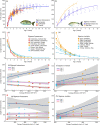Maximization of fitness by phenological and phenotypic plasticity in range expanding rabbitfishes (Siganidae)
- PMID: 35543704
- PMCID: PMC9546425
- DOI: 10.1111/1365-2656.13739
Maximization of fitness by phenological and phenotypic plasticity in range expanding rabbitfishes (Siganidae)
Abstract
Global warming is modifying the phenology, life-history traits and biogeography of species around the world. Evidence of these effects have increased over recent decades; however, we still have a poor understanding of the possible outcomes of their interplay across global climatic gradients, hindering our ability to accurately predict the consequences of climate change in populations and ecosystems. We examined the effect that changes in biogeography can have on the life-history traits of two of the most successful range-extending fish species in the world: the tropical rabbitfishes Siganus fuscescens and Siganus rivulatus. Both species have established abundant populations at higher latitudes in the northern and southern hemispheres and have been identified as important ecological engineers with the potential to alter the community structure of seaweed forests (Laminariales and Fucales) in temperate regions. Life-history trait information from across their global distribution was compiled from the published literature and meta-analyses were conducted to assess changes in (i) the onset and duration of reproductive periods, (ii) size at maturity, (iii) fecundity, (iv) growth rates, (v) maximum body sizes and (vi) longevity in populations at the leading edge of range expansion in relation to sea surface temperature and primary productivity (a common proxy for nutritional resource levels). Populations at highest latitudes had shortened their reproductive periods and reduced growth rates, taking longer to reach sexual maturity and maximum sizes, but compensated this with higher fecundity per length class and longer lifespans than populations in warmer environments. Low primary productivity and temperature in the Mediterranean Sea resulted in lower growth rates and body sizes for S. rivulatus, but also lower length at maturity, increasing life-time reproductive output. The results suggest that plasticity in the phenology and life-history traits of range-expanding species would be important to enhance their fitness in high latitude environments, facilitating their persistence and possible further poleward expansions. Quantifying the magnitude and direction of these responses can improve our understanding and ability to forecast species redistributions and its repercussions in the functioning of temperate ecosystems.
Keywords: climate change; global warming; life-history traits; plasticity; rabbitfish; range-shifts; temperature-size-rule; tropicalization.
© 2022 The Authors. Journal of Animal Ecology published by John Wiley & Sons Ltd on behalf of British Ecological Society.
Conflict of interest statement
The authors have no conflict of interest to declare.
Figures





Similar articles
-
Phenological response to climate variation in a northern red oak plantation: Links to survival and productivity.Ecology. 2023 Mar;104(3):e3940. doi: 10.1002/ecy.3940. Epub 2023 Jan 6. Ecology. 2023. PMID: 36457179
-
Physiological Traits for Predicting Poleward Extensions in Tropical Fishes: From Lab to Management.Glob Chang Biol. 2025 Apr;31(4):e70213. doi: 10.1111/gcb.70213. Glob Chang Biol. 2025. PMID: 40290058 Free PMC article. Review.
-
Elevation and latitude interact to drive life-history variation in precocial birds: a comparative analysis using galliformes.J Anim Ecol. 2016 Nov;85(6):1528-1539. doi: 10.1111/1365-2656.12570. Epub 2016 Aug 18. J Anim Ecol. 2016. PMID: 27392151
-
The tropicalization of temperate marine ecosystems: climate-mediated changes in herbivory and community phase shifts.Proc Biol Sci. 2014 Aug 22;281(1789):20140846. doi: 10.1098/rspb.2014.0846. Proc Biol Sci. 2014. PMID: 25009065 Free PMC article.
-
Tropicalization of temperate ecosystems in North America: The northward range expansion of tropical organisms in response to warming winter temperatures.Glob Chang Biol. 2021 Jul;27(13):3009-3034. doi: 10.1111/gcb.15563. Epub 2021 Mar 17. Glob Chang Biol. 2021. PMID: 33605004 Review.
References
-
- Ahti, P. A. , Kuparinen, A. , & Uusi‐Heikkilä, S. (2020). Size does matter – the eco‐evolutionary effects of changing body size in fish. Environmental Reviews, 28, 311–324.
-
- Akiyama, S. , Naganuma, M. , & Katayama, S. (2009). Annual life cycle of rabbitfish Siganus fuscescens in Tateyama Bay, Chiba prefecture. Fisheries Engineering, 46, 107–115.
-
- Angilletta, M. J. , Steury, T. D. , & Sears, M. W. (2004). Temperature, growth rate, and body size in ectotherms: Fitting pieces of a life‐history puzzle. Integrative and Comparative Biology, 44, 498–509. - PubMed
-
- Assis, J. , Tyberghein, L. , Bosch, S. , Verbruggen, H. , Serrão, E. A. , & De Clerck, O. (2018). Bio‐ORACLE v2.0: Extending marine data layers for bioclimatic modelling. Global Ecology and Biogeography, 27, 277–284.
Publication types
MeSH terms
Associated data
Grants and funding
LinkOut - more resources
Full Text Sources

